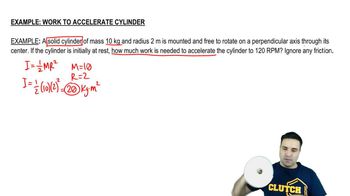13. Rotational Inertia & Energy
Conservation of Energy with Rotation
Learn with other creators
Practice this topic
- Multiple Choice
How much work is needed to stop a hollow sphere of mass 2 kg and radius 3 m that spins at 40 rad/s around an axis through its center?
615views8rank1comments - Multiple Choice
Two solid cylinders of same mass and radius roll on a horizontal surface just before going up an inclined plane. Cylinder A rolls without slipping, but cylinder B moves along a slippery path, so it moves without rotating at all times. At the bottom of the incline, both have the same speed at their center of mass. Which will go higher on the inclined plane? (Why?)
637views7rank2comments - Textbook Question
(II) Two masses, mₐ = 35.0 kg and m₈ = 41.0 kg, are connected by a rope that hangs over a pulley (as in Fig. 10–67). The pulley is a uniform cylinder of radius R = 0.311 m and mass 3.1 kg. Initially mₐ is on the ground and m₈ rests 2.5 m above the ground. If the system is released, use conservation of energy to determine the speed of m₈ just before it strikes the ground. Assume the pulley bearing is frictionless.
<IMAGE>
244views - Textbook Question
(III) A 2.30-m-long pole is balanced vertically on its tip. It starts to fall and its lower end does not slip. What will be the speed of the upper end of the pole just before it hits the ground? [Hint: Use conservation of energy.]
227views - Textbook QuestionA long, thin rod of mass M and length L is standing straight up on a table. Its lower end rotates on a frictionless pivot. A very slight push causes the rod to fall over. As it hits the table, what are (b) the speed of the tip of the rod?378views
- Textbook QuestionA long, thin rod of mass M and length L is standing straight up on a table. Its lower end rotates on a frictionless pivot. A very slight push causes the rod to fall over. As it hits the table, what are (a) the angular velocity660views






